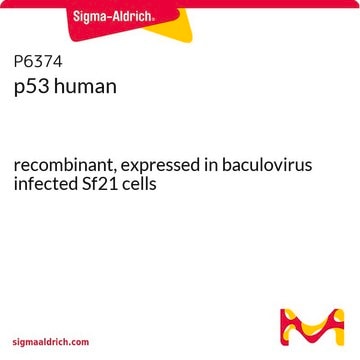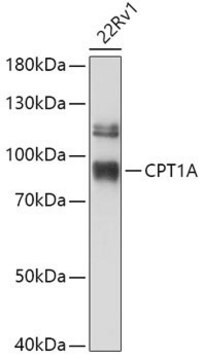ABE286
Anti-acetyl-p53 (Lys120) Antibody
from rabbit, purified by affinity chromatography
Sinónimos:
Cellular tumor antigen p53, Antigen NY-CO-13, Phosphoprotein p53, Tumor suppressor p53
About This Item
Productos recomendados
origen biológico
rabbit
Nivel de calidad
forma del anticuerpo
affinity isolated antibody
tipo de anticuerpo
primary antibodies
clon
polyclonal
purificado por
affinity chromatography
reactividad de especies
human
reactividad de especies (predicha por homología)
porcine (based on 100% sequence homology), canine (based on 100% sequence homology), rabbit (based on 100% sequence homology), sheep (based on 100% sequence homology)
técnicas
dot blot: suitable
immunoprecipitation (IP): suitable
Nº de acceso NCBI
Nº de acceso UniProt
Condiciones de envío
wet ice
modificación del objetivo postraduccional
acetylation (Lys120)
Información sobre el gen
human ... TP53(7157)
Descripción general
Especificidad
Inmunógeno
Aplicación
Immunoprecipitation Analysis: 1 µg from a representative lot immunoprecipitated acetyl-p53 in p53 transfected H1299 human lung cotransfected with or without hMOF (Prof. S. McMahon, Kimmel Cancer Center of Thomas Jefferson Medical College).
Immunoprecipitation Analysis: 1.5 µg or 4.5 µg from a representative lot immunoprecipitated endogenous acetyl-p53 in HCT116 cell lysates, which were treated with a vehicle (DMSO) or camptothecin (CPT) (Prof. S. McMahon, Kimmel Cancer Center of Thomas Jefferson Medical College).
Immunoprecipitation Analysis: 1 µg from a representative lot immunoprecipitated acetyl-p53 in H1299 cell lysates, which were transfected with either wild type p53, the 9 K/R mutant (all lysine residues except Lys120 mutated to arginine), the 10 K/R mutant (all lysine residues mutate including Lys 120), or empty vector, with or without hMOF (Prof. S. McMahon, Kimmel Cancer Center of Thomas Jefferson Medical College).
Epigenetics & Nuclear Function
Transcription Factors
Calidad
Dot Blot Analysis: 1 µg/mL of this antibody detected acetyl-p53 in acetylated p53 peptides
Descripción de destino
Forma física
Almacenamiento y estabilidad
Nota de análisis
Non-acetylated and acetylated p53 peptides
Otras notas
Cláusula de descargo de responsabilidad
¿No encuentra el producto adecuado?
Pruebe nuestro Herramienta de selección de productos.
Código de clase de almacenamiento
12 - Non Combustible Liquids
Clase de riesgo para el agua (WGK)
WGK 1
Punto de inflamabilidad (°F)
Not applicable
Punto de inflamabilidad (°C)
Not applicable
Certificados de análisis (COA)
Busque Certificados de análisis (COA) introduciendo el número de lote del producto. Los números de lote se encuentran en la etiqueta del producto después de las palabras «Lot» o «Batch»
¿Ya tiene este producto?
Encuentre la documentación para los productos que ha comprado recientemente en la Biblioteca de documentos.
Nuestro equipo de científicos tiene experiencia en todas las áreas de investigación: Ciencias de la vida, Ciencia de los materiales, Síntesis química, Cromatografía, Analítica y muchas otras.
Póngase en contacto con el Servicio técnico








